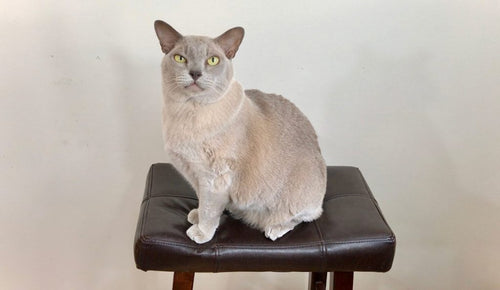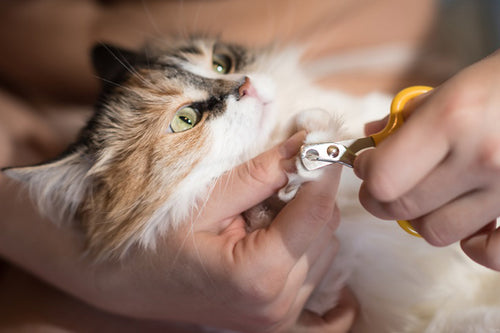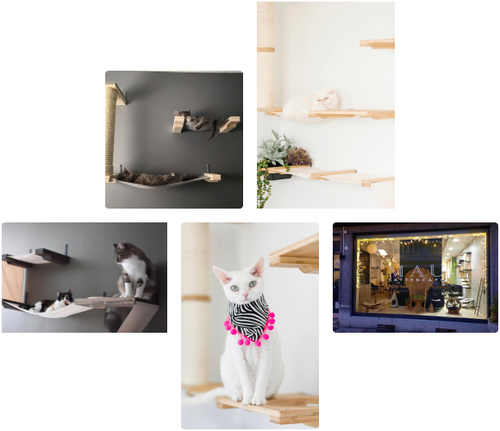Do you wonder how to train a cat? In excitement maybe you mused, “I want to do everything right with my adorable newly adopted kitten.” Or in frustration, sighed, “I’m at my wit’s end trying to get my cat to behave!” Maybe, you simply want to train fun tricks such as high five or twirl to impress your friends. Or do you struggle trimming nails or getting your cat into the carrier without a fight so you can make your vet appointment on time?
There is help. Read on to follow simple tips and techniques on how to train your cat, have fun, and bond with your happy, healthy kitty. The information is based on my personal experience implementing guidelines from the International Association of Animal Behavior Consultant’s Humane Hierarchy for training and behavior modification.
5 Points to Remember
1. Starting Cat Training – provide basic necessities and monitor health
Cats do wacky things. Often these are instinctual or social behaviors. First and foremost, meeting your cat’s needs helps them feel safe, lowers their stress, and often resolves troublesome behaviors.
When you are concerned your sweet kitty is not behaving as usual, it is important to have your cat examined by your veterinarian. Poor health can be an underlying cause of behavior issues (eliminating outside the litter box, excessive vocalization, or aggressive behavior). Healing physical illness, including hidden pain, often solves behavior problems. Training will be more fun and appealing when your cat feels well.

2. Let Your Cat Decide the Exciting Training Paycheck
What reinforcer (reward) will your cat work for? With positive reinforcement training, a reinforcer is something wonderful your cat will be extremely motivated to obtain, therefore, increasing the frequency of the desirable behavior in the future. Upon hearing the treat bag crinkle, our cat Caleb flies down the stairs at top speed to see what we have to offer. Does your cat do the same?
What Are the Best Cat Treats for Training?
- Churu puree
- Puree chicken baby food
- Freeze dried chicken, fish, liver
- Can cat food
- Tuna, tuna juice
- Temptations (break in half)
- Cheese, butter, whip cream (if cat is not dairy sensitive)
- Kibble

Non-food reinforcers include fun activity, toys, attention such as petting, brushing, an opportunity to investigate a closed off room, or even an opportunity to explore with us in the wild outdoors.
Every cat is different. Test to see what reinforcer excites your cat.
Non-Food Reinforcers: Training without Food
Choosing Reinforcer-Reward Clicker Training

Helpful Training Tips
- Deliver reinforcer (reward) within 1-2 seconds after behavior.
- Food/treat should be pea size.
- Give one treat or a few licks of food.
- Food/treat is more desirable when your cat is hungry. Train before meals. Pick up food bowl after your cat finishes eating.
- Keeping small covered containers of kibble or treats within reach, allows for quick reinforcement of desirable behavior.
3. Decide Which Behavior You Want to Train
Why is your cat misbehaving? Determine the function of the behavior. Is it attention seeking, sensory stimulation, access to tangibles such as food, or desiring escape from things that cause fear or anxiety? To answer this, be a detective by asking the following questions.
a) What observable behavior occurs? Describe details.
b) What happens right before the behavior that triggers it?
c) What occurs after the troublesome behavior that reinforces it?
d) What time of day and where does the trouble predictably occur?
e) Who is present, either other animals or humans?
f) What does your cat’s body language look like? Pay attention to position of body, legs, tail, head, mouth, whiskers, ears, eyes, as well as any vocalization.


Manage the environment. Prevent your cat from practicing undesirable behaviors. Decide what you could change either before or after the challenging behavior. Usually there are items you could rearrange in your home that will help.
What behavior do you want your cat to do instead? You know what you do not want your cat to do, “Stay off the counter.” “Not to scratch furniture.” “Not to bite.” Flip your thoughts by declaring, “I want my cat to perform this alternative behavior that fills her need.” This is very important to achieve success.
For example, if Softie is on the counter to access food while you cook:
- Keep counters clear of food after cooking, avoiding unintentionally tempting Softie to walk on the counters looking for food.
- Train an incompatible alternate behavior. Train your cat to sit on a nearby stool.
- Place food puzzles around your home. This provides interesting sensory stimulation of hunting and will delight your kitty.
- Our energetic cat Caleb has a sanctuary room for time outs. The room has everything Caleb needs – toys, food puzzle, water, litter box, scratching pad, and a choice of places to rest. With the door closed, cat music playing, he falls asleep in his cozy bed. (Hampton, 2019)
4. Nitty Gritty of Training Kitty – Capturing, Luring, Shaping
You just want to train fun tricks? Use these three fundamental techniques: capturing, luring, and shaping. Training is quicker when you use a clicker to mark the exact moment of the behavior. Then within 1-2 seconds give the treat or other reinforcer. Hearing the click, your cat will eventually have an “Aha!” moment, realizing you are saying, “Yes, that is the behavior I want! I will give you a yummy treat!”
Keep your sessions to a few minutes. Repeat the following steps many times in the week. Muscle memory is key to successful behavior changes. End with an easy behavior. Have fun!
- Capturing:
At the moment your cat naturally does a behavior, such as sit, click or say “good”, and immediately give the reinforcer (reward).
Our cat Mallory would joyfully plop down, rolling onto her back. Immediately, we captured the behavior by giving a treat. Eventually, we added a verbal cue.
- Luring:
Guide your cat through a behavior as kitty follows food, target stick, or your finger.
Click and give reinforcer (reward).
When you can tell the behavior will reliably occur, add a verbal or physical cue right before the lure motion. After the behavior, click and give reinforcer. Repeat many times.
Gradually fade out using the lure by first giving the cue, then adding a couple seconds each time before presenting the lure. Click and reinforce.
- Shaping:
Similar to molding a clump of clay little by little, a goal behavior is shaped into the final image you are visualizing in your mind.
Reinforce each small part of the behavior that resembles the goal behavior. With successive approximations the behavior appears more and more like the desired goal behavior.
Finally, the desired behavior is performed and reinforced.
5. Training Tips for Anxious Cats
Does your heart ache for your scaredy cat? Use these three techniques to help your cat relax instead of hiding or fighting when faced with something frightening: distraction technique, desensitization and counterconditioning.
Distraction technique:
Distraction is beneficial for short durations, but it does not teach your cat to overcome anxiety. Applicable situations include veterinary examinations, procedures, and grooming (Howell & Feyrecilde, 2018, pp. 134-147).
Apply distraction technique by continuously delivering delicious treats during exposure to the fear inducing stimulus.
Desensitization and counterconditioning:
Implementing desensitization and counterconditioning will help your cat overcome fear. Pairing something extremely enjoyable during this process changes your cat’s emotional response to the fear inducing stimulus from fearful to positive, relaxed. Scary things may include loud noises, strange people, animals, grooming, or handling (Howell & Feyrecilde, 2018, pp. 60-63).
For success, carefully follow these few steps. Expose your cat to the fear inducing stimulus at a very low-level intensity that does not cause a negative response.
Accomplish this by increasing distance or lowering the sound volume. This is called staying under threshold. Pay attention to your cat’s body language for signs of relaxation.
After looking at the stimulus, your cat looks to you, and receives something wonderful. If not a treat, maybe you provide an opportunity to play. Eventually, seeing the stimulus will predict that the wonderful treat will appear.
After many repetitions, very slowly increase the intensity (decrease distance or increase sound volume) of the fear inducing stimulus during the treat pairing process. Staying under threshold is crucial for success.
Caleb overcoming fear of loud construction.
Are You Excited to Train Your Cat?
For more guidance, wonderful professional resources include veterinary behaviorists and certified cat behavior consultants.
Whether teaching fun tricks or changing troublesome behavior, cat training is very rewarding. Now that you know the basics of how to train a cat, seeing your more affectionate kitty respond to you will be heart-warming.
References
Hampton, A., Ford, A., Cox, R., Liu, C., Koh, R. (2019). Effects of music on behavior and physiological stress response of domestic cats in a veterinary clinic. Journal of Feline Medicine and Surgery, https://doi.org/10.1177/1098612X19828131
Howell, A. & Feyrecilde, M., (2018). Cooperative Veterinary Care. pp. 60-63, pp.134 – 147. Wiley Blackwell.















